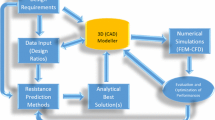Abstract
This chapter revisits the combined effects of the aero- and hydromechanic forces and there mutual interaction in some further detail, with particular attention for the performance aspects. The first section addresses the problem of optimizing boat performance and the role therein of so-called Velocity Prediction Programs (VPP). Next, the dependence of (upwind) boat performance on the shapes of hull, sails and appendages is illustrated through applications of a VPP developed by the author. The chapter (and the book) is concluded with discussions on directional stability, dynamic interactions in rolling and yawing motions and sailing in waves.
Access this chapter
Tax calculation will be finalised at checkout
Purchases are for personal use only
Similar content being viewed by others
Notes
- 1.
For multiple sails there will, in general, be a sheeting angle δ and angle of attack α for each individual sail.
- 2.
Additional variables are involved for yachts with a trim tab, water ballast or a canting keel.
- 3.
If the incidence of the keel would be set such so as to reduce the angle of leeway of the centre plane of the hull, the resistance of the hull would be marginally smaller. There will also be an effect on the yawing (“Munk”) moment of the hull and an associated change in the induced resistance of the rudder due to the different balance in yaw.
- 4.
For q = 279, the expression for the heel forcing factor Kφ becomes equal to the so-called Dellenbaugh angle, a rough measure of the stiffness of a yacht (Larsson and Eliasson 1996).
- 5.
Note that this behaviour was already anticipated in Sect. 7.4.
- 6.
Made dimensionless by hydrodynamic quatities (made dimensionless by hydrodynamic quatities (ρH, V b, Sk, LWL)).
- 7.
Recall at this point that a larger value of xk implies an increased ‘lead’ (distance) between the centre of effort (CE) of the sails and the centre of lateral resistance (CLR) of the underwater body.
- 8.
Note that the apparent wind angle β is 35° rather than the 30° in the preceding figures.
- 9.
Partly also because the effect of the rudder on the hydrodynamic damping was not taken into account. It is estimated that, with rudder, the hydrodynamic damping would increase by ≅ 25 %.
References
Bethwaite F (2010) High performance sailing, 2nd edn. Adlard Coles Nautical, London, pp 311–314
Claughton AR, Shenoi RE, Wellicom JF (eds) (1999) Sailing yacht design: theory, Chap 7. Prentice Hall, Upper Saddle River. ISBN 0582368561
Fossati F (2009) Aero-hydrodynamics and the performance of sailing yachts. International Marine, New York, p 179. ISBN 978-0-07-162910-2
Fossati S, Muggiasca S, Martina F (2008) Experimental database of sail performance and flying shapes in upwind conditions. International conference on innovation in high performance sailing yachts, Lorient, 29–30 May
Gerritsma J, Moeyes G, Onnink R (1977) Test results of a systematic yacht hull series. 5th HISWA symposium yacht architecture
Hazen GS (1980) A model of sail aerodynamics for diverse rig types. New England yacht symposium, New London
Kerwin JE (1978) A velocity prediction program for ocean racing yachts (Rept 78-11). MIT, Cambridge, July
Larsson L, Eliasson RE (1996) Principles of yacht design. Adlard Coles Nautical, London. ISBN 0-7136-3855-9
Letcher JS Jr (1965) Balance of helm and static directional stability of yachts sailing close-hauled. JRAeS 69(652):241–248
Munk MM (1923) General bi-plane theory. NACA Report 151
ORC-VPP Documentation (2012) Off-shore racing congress
Proceedings 22nd HISWA symposium on yacht design and yacht construction, Amsterdam, Nov. 2012
Van Oossanen P (1993) Predicting the speed of sailing yachts. SNAME Trans 101:337–397
Author information
Authors and Affiliations
Corresponding author
Rights and permissions
Copyright information
© 2015 Springer International Publishing Switzerland
About this chapter
Cite this chapter
Slooff, J. (2015). Encore: Sailing; Aerodynamics Plus Hydromechanics. In: The Aero- and Hydromechanics of Keel Yachts. Springer, Cham. https://doi.org/10.1007/978-3-319-13275-4_8
Download citation
DOI: https://doi.org/10.1007/978-3-319-13275-4_8
Published:
Publisher Name: Springer, Cham
Print ISBN: 978-3-319-13274-7
Online ISBN: 978-3-319-13275-4
eBook Packages: EngineeringEngineering (R0)




